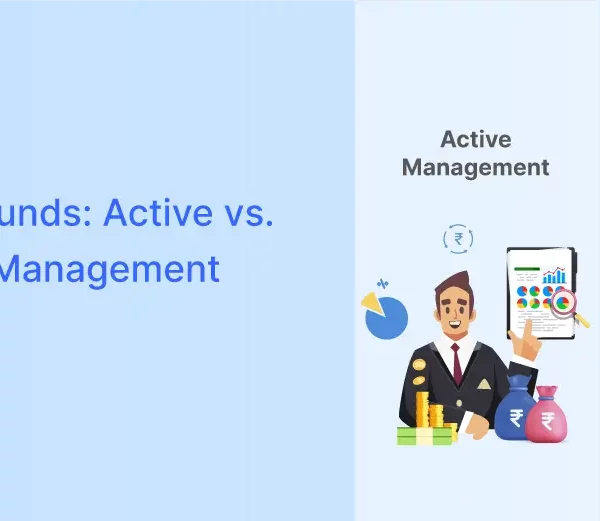Maintaining a well-balanced mutual fund portfolio is essential for long-term investment success. The Association of Mutual Funds of India has stated a staggering 5x increase in Assets Under Management (AUM) of the Indian Mutual Fund Industry, going from ₹ 8.68 trillion to ₹43.20 trillion in 10 years as of May 2023. But not all your mutual fund schemes need to provide equal returns.
Over time, the performance of different funds can lead to an imbalance in your asset allocation portfolio. So, it is necessary to check that your portfolio is not overly inclined toward a particular sector.
For instance, stock markets made a sharp fall during COVID-19. It significantly reduced the value of equity in the portfolios. But what followed was a V-shaped recovery that increased the equity value.
Rebalancing your portfolio would have involved infusing capital when markets were low and reducing the equity portion when markets were high. It would have allowed investors to book gains from this turbulence.
(This example is for illustration purposes only.)’Rebalancing your portfolio would have involved infusing capital when markets were low and reducing the equity portion when markets were high. It would have allowed investors to book gains from this turbulence. (This example is for illustration purposes only.)
Rebalancing your mutual fund portfolio is crucial to managing your investments with your desired asset allocation. Let’s understand what adjusting mutual funds is and how you can rebalance your portfolio with Koshex.
What is Mutual Fund Portfolio Rebalancing?
Mutual fund portfolio rebalancing is the process of adjusting your mutual fund investments to bring them back in line with your desired asset allocation.
Asset allocation refers to the percentage of your portfolio allocated to different asset classes such- as stocks, bonds, and cash. It focuses on your desired allocation strategy, risk profile, and investment goals, even as the market fluctuates.
How to Rebalance Your Portfolio?
Rebalancing your Mutual fund portfolio is not a one-time exercise. It is a recurring effort to coordinate your portfolio allocation and investment strategy. Here’s how you can rebalance your portfolio:
Set your target asset allocation
Firstly, you must determine your desired asset allocation to different asset classes. Base it on your risk profile, investment horizon, and financial goals. For instance, you may allocate 60% to stocks and 40% to bonds. It lays the foundation for your future portfolio rebalancing.
Review your current asset allocation
Evaluate your portfolio’s current asset allocation (based on the current market value of your investments). You can do this by analyzing the percentage of your investments in each asset class. Compare it with your target allocation.
Identify the imbalances
Identify the asset classes that have deviated from your target allocation. If the percentage is higher than your target, it indicates an overweight position. Conversely, a lower figure suggests an underweight position.
Determine the Rebalancing Strategy
After you identify the imbalance, you should determine the rebalancing strategy. There are two common strategies:
- a) Sell and Buy: If an asset class is overweight, consider selling some of the investments to reduce its percentage. You can use the proceeds to buy investments in underweight asset classes.
- b) New Investments: Instead of selling existing investments, you can direct new investments towards the underweight asset classes to balance them with your target allocation.
Execute the rebalancing
Implement your chosen investment strategy depending on your portfolio and calculations. Follow the appropriate procedures outlined through an investment platform like Koshex.
Monitor and repeat
Regularly monitor your portfolio’s asset allocation and rebalance as needed. You must review and rebalance your portfolio at least half-yearly, annually, or when significant deviations from the target allocation occur.
A Practical Example of Mutual Fund Portfolio Rebalancing
Let’s say your target allocation is 60% in equity funds and 40% in debt funds. Over time, equity funds performed better than debt funds. Due to this, your portfolio allocation shifted to 65% equity funds and 35% debt funds.
To rebalance your portfolio, you can implement either of the two strategies discussed above: sell a portion of your equity funds and buy new bonds to balance your assets, or directly make a new investment in debt funds. Both strategies will bring your portfolio back on track.
Thus, portfolio rebalancing can help you book quick gains in a highly volatile market. If the markets fall significantly, the equity portion of your portfolio will also reduce significantly. Here, you can invest more in equity to rebalance your portfolio.
When the market rises again, the value of equity will also increase. Here, you can reduce your equity value by selling it and reinvesting in debt or other assets in your portfolio. It not only helps you maintain your asset allocation but also takes advantage of market turbulence.
Importance of Rebalancing Your Mutual Fund Portfolio
Rebalancing your mutual fund portfolio is important for many reasons. Some of them include the following:
Maintains the desired risk level
Rebalancing ensures that your portfolio’s risk remains within your risk profile. It prevents excessive exposure to one asset class that may become riskier over time.
Controls portfolio drift
Market fluctuations can cause your portfolio to drift away from your target allocation. It also deviates you from your decided investment strategy. But rebalancing helps to manage it, preventing your portfolio from becoming heavily skewed towards certain assets.
Captures investment opportunities
Open up wider investment opportunities in assets that have become relatively undervalued as you rebalance your portfolio. Also, you can potentially enhance your returns by selling overperforming assets and reallocating them to underperforming ones.
Disciplined investing approach
Rebalancing helps you follow a disciplined approach to investment by preventing emotional decision-making based on short-term market movements. It keeps your portfolio aligned with your long-term investment strategy.
Aligns with your changing goals
As your financial goals evolve, you need to adjust your asset allocation. Rebalancing provides an opportunity to reassess your investment objectives and make appropriate changes. You should review your portfolio periodically, assess its performance, and adjust it accordingly.
In a Nutshell
Rebalancing is critical for maintaining a well-structured investment portfolio. As you realign your investments with your target asset allocation, you can manage risk, capture opportunities, and stay on track to achieve your long-term financial goals.
Regular monitoring and disciplined execution are keys to successful portfolio rebalancing. For younger generations, portfolio rebalancing is a must in the early stages of their investment journey. It helps them understand market risks, form their own investment strategies, and build a dynamic portfolio to withstand market turbulence. Selecting the right schemes for portfolio rebalancing will ensure they can navigate it properly while booking profits when the opportunity arises.
Koshex provides you with 5,000 different mutual fund schemes to choose from. You can create your portfolio allocation strategy and select the desired funds from this large pool. It helps you stay diversified and achieve your short and long-term investment goals. To invest and rebalance your portfolio, sign up with Koshex.
FAQs
How often should I rebalance my mutual fund portfolio?
You can rebalance your portfolio depending on your personal preference and the level of deviation from your target allocation. The general guideline suggests annual or semi-annual reviews. However, if your portfolio is experiencing significant variation or changes in your financial goals, frequent rebalancing may be necessary.
Does it cost money to rebalance my mutual fund portfolio?
Portfolio rebalancing does not cost any money but may involve exit loads, transaction costs, or taxes on the redemption of investments.
Is rebalancing necessary in a well-diversified portfolio?
Asset classes can experience different performances, leading to imbalances even in a well-diversified portfolio. Rebalancing ensures that your portfolio remains aligned with your desired risk profile and investment strategy, regardless of diversification.









Leave a Comment